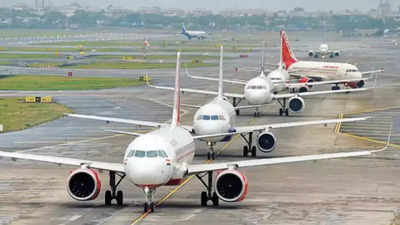
NEW DELHI: Second airports that will soon start opening in Indian cities/regions could be relatively more expensive than the single ones operating there so far.
The reason: A majority of them will need to compete for traffic with the existing ones. The Airports Economic Regulatory Authority (AERA)’s ad hoc tariff order for GMR-developed Goa International Airport Ltd (GIAL), Mopa — which will open in the next few months in addition to Dabolim and make Goa the first desi city with twin commercial airports — explains the issue secondary facility will face. After Goa, Delhi and Mumbai will get secondary airports at Greater Noida and Navi Mumbai.
“Government of India had decided to close down the operational airports (in Bengaluru and Hyderabad)… to make sure benefit of traffic is available exclusively to (the new) airports. On the other hand, Goa International Airport Ltd (GIAL), Mopa, shall entail new beginning in airport infrastructure development and competition as it shall involve two airports in the vicinity — Dabolim and Mopa — competing with each other for the same traffic. Authority is conscious of the view that GIAL, MOPA shall have its challenges and uncertainties at least in initial stages due to competition, unknowns about shifting of traffic and response of the airlines,” the ad hoc tariff order says.
AERA has approved an ad hoc aeronautical charges tariff order that includes user development fee (UDF) of Rs 450 and Rs 1,100 per departing domestic and international passengers, respectively, from Mopa till March 31, 2023. The GMR Group, that has developed Mopa, had proposed a UDF of Rs 980 and Rs 1,500. The authority felt “the proposal of the airport operator is on higher side and needs to be moderated.”
The authority has decided to allow GIAL, Mopa, to charge the ad hoc tariff till March 31, 2023, or if the regular tariff order is issued before that.
Explaining the difference between tariff orders being issued for second airports that will now start opening and the past, AERA says the existing airports in Bengaluru (HAL) and Hyderabad (Begumpet) were closed for commercial flights when new ones opened there in 2009 and 2008, respectively, and accordingly the government had approved ad hoc tariffs those new airports then.
Mumbai’s existing airport had saturated in terms of both aircraft and passenger handling capacity pre-Covid. Navi Mumbai will not have to wait to get its share of traffic. Goa and Delhi, however, will be a different story. Delhi’s IGIA has the capacity to grow and will reach its peak traffic handling capacity by the end of this decade. So, Greater Noida will have to compete to attract airlines and passengers till 2030. After that, airlines wanting to add flights will have no option but to do so at Greater Noida’s Jewar. Same will be the case at Goa.
The fight for survival will be in the first few years till the existing airports get saturated and are unable to handle more traffic, the case with Mumbai.
FacebookTwitterInstagramKOO APPYOUTUBE